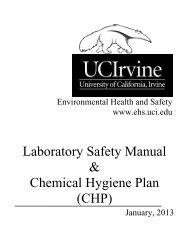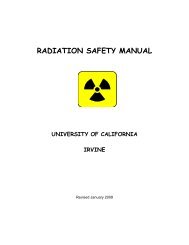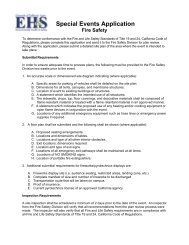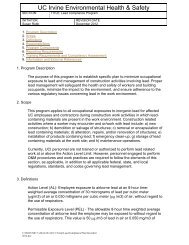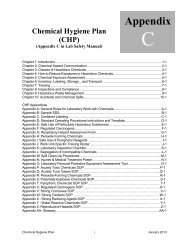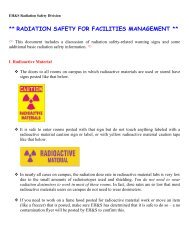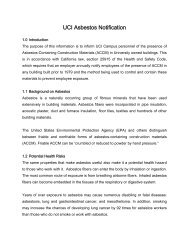Explosion Using Distillation for Final Purification of Tosylated
Explosion Using Distillation for Final Purification of Tosylated
Explosion Using Distillation for Final Purification of Tosylated
Create successful ePaper yourself
Turn your PDF publications into a flip-book with our unique Google optimized e-Paper software.
LESSONS LEARNED MEMO<br />
EXPLOSION IN A CHEMISTRY RESEARCH LAB USING DISTILLATION FOR<br />
FINAL PURIFICATION OF TOSYLATED COMPOUND<br />
What Happened:<br />
A flask exploded inside the fume hood when a chemistry graduate student at FRH was in the<br />
process <strong>of</strong> purifying a tosylated alkyne compound using a vacuum distillation. The student had<br />
completed the tosylation reaction involving 20 grams <strong>of</strong> 4-pentyn-1-ol with 50 gram <strong>of</strong> p-<br />
tolunesulfonyl chloride in the presence <strong>of</strong> 36.5 ml <strong>of</strong> triethylamine and 250 ml <strong>of</strong> di-ethyl ether. A<br />
peroxide test strip indicated that the peroxide level within the ether container was less than 0.5<br />
ppm. After completion <strong>of</strong> the reaction, the triethylamine/HCl salt was filtered and the remaining<br />
mixture was placed in a rotary evaporator and the liquid volume reduced to 50 ml. The mixture<br />
was then placed in a 100 ml flask under vacuum at 120-130 degrees centigrade <strong>for</strong> the distillation<br />
process.<br />
The explosion occurred as the student was raising the fume hood sash to lower the temperature<br />
setting on the hotplate after observing that the liquid mixture inside the flask turned black in<br />
color.<br />
The student received a small cut on the <strong>for</strong>ehead from the broken glass and a first-degree burn on<br />
the left arm from the hot silicone oil. The ceramic top <strong>of</strong> the magnetic hot plate and the 100 ml<br />
distillation flask shattered into pieces; however, there was no structural damage.<br />
The student was using safety glasses and nitrile gloves at the time <strong>of</strong> the incident.<br />
What Was Learned:<br />
Tosylation is commonly done in organic chemistry labs without any incident. This was an<br />
isolated case most probably because distillation was used as a final step, which is not a typically<br />
used procedure <strong>for</strong> its purification. The alternative column chromatography procedure <strong>for</strong> final<br />
purification should have been used; one should consider distillation free procedure as a method <strong>of</strong><br />
choice.<br />
It is preferable to avoid the use <strong>of</strong> ethers at any stage <strong>of</strong> a reaction in which distillation is<br />
per<strong>for</strong>med. Even though the bottle <strong>of</strong> ether used in this reaction has inhibitor in it and the<br />
measurement <strong>of</strong> peroxides turned out to be less than 0.5 ppm, the peroxides can easily<br />
concentrate as volatile solvents are removed during rotary evaporation and distillation to the<br />
extent that it can explode. If you choose to distill peroxide-<strong>for</strong>ming solvents, please familiarize<br />
yourself with the associated hazards prior to distillation. In certain operations, ethyl acetate can<br />
usually be substituted <strong>for</strong> ether.<br />
Some <strong>of</strong> the sulfur esters are thermally unstable, especially the esters <strong>of</strong> unsaturated alcohols.<br />
They are likely to polymerize in the presence <strong>of</strong> liberated acids as a catalyst. Acetylene groups<br />
are also suspect <strong>for</strong> explosive instability since a wide range <strong>of</strong> acetylenic compounds are prone to<br />
explosive polymerization. The observed color change in the distillation flask from clear to black<br />
right be<strong>for</strong>e the explosion is probably indicative <strong>of</strong> a runaway reaction or polymerization.<br />
AlcoholTosylation<strong>Explosion</strong>2.doc Page 1 <strong>of</strong> 2 4/26/07
Incident Root Cause:<br />
The root cause <strong>of</strong> the incident was inadequate hazard evaluation <strong>of</strong> the available purification<br />
methods. Each method should have been analyzed <strong>for</strong> their hazard potential, especially when the<br />
student opted to use a heated method to purify the solvent instead <strong>of</strong> column chromatography.<br />
Recommended Corrective Actions:<br />
1. Prepare a written SOP approved by the PI <strong>for</strong> all hazardous operations and follow it<br />
strictly. This becomes even more important when you’re trying to scale up or vary the<br />
proven methodology <strong>for</strong> a particular reaction.<br />
2. Evaluate the potential hazards associated with the experiment especially when there’s a<br />
change in conditions or compounds that makes this a new procedure. A new hazard may<br />
be introduced as a result <strong>of</strong> side reactions. Consult additional sources such as Bretherick’s<br />
Handbook <strong>of</strong> Reactive Chemical Hazards.<br />
3. Do not raise the sash immediately when an unexpected event suddenly transpires inside<br />
the hood. Evaluate the process and if the operation is heated disconnect the power to the<br />
experiment from outside <strong>of</strong> the hood.<br />
4. Always use appropriate Personal Protective Equipment (PPE) like gloves, lab coat, and<br />
safety glasses when working with hazardous chemicals; you may need to upgrade to<br />
goggles, face shield, etc. where there’s a potential <strong>for</strong> explosion or fire.<br />
5. Never work alone while handling hazardous materials or operations.<br />
6. Know in advance how to use safety equipment such as fire extinguishers and their<br />
location. Make sure the fire extinguisher is appropriate <strong>for</strong> the hazards in the area.<br />
7. Know in advance how to access medical care properly during emergencies at UC Irvine.<br />
Use 911 calls <strong>for</strong> transporting injured employee after an explosion or fire where condition<br />
<strong>of</strong> the employee could be life threatening.<br />
8. The location <strong>of</strong> hazardous operations must be properly and adequately separated from<br />
hazardous materials storage areas.<br />
AlcoholTosylation<strong>Explosion</strong>2.doc Page 2 <strong>of</strong> 2 4/26/07



